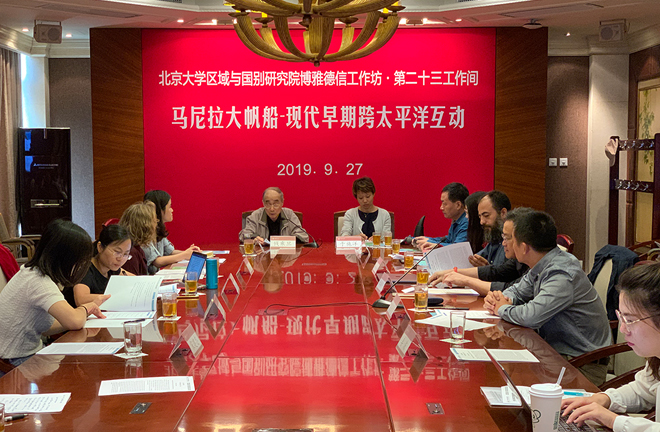Manila Galleon established dense transpacific network in Ming and Qing

At the workshop “Manila Galleon: Trans-Pacific Interactions in Early Modern Age” on Sept. 27, scholars discussed the activities of Manila Galleon in the Pacific region. Photo: Lan Min/PKU
“In the past decades, issues such as trade and maritime navigation have received increasing attention from international academic circles. However, the main focus has been on commercial activities in the Atlantic region, with many gaps of research in the Pacific region. These gaps have been noticed by more and more scholars in recent years,” Qian Chengdan, director of the Institute of Area Studies at Peking University (PKUIAS) and Boya Chair Professor at PKU, said at the workshop “Manila Galleon: Trans-Pacific Interactions in Early Modern Age” on Sept. 27. Scholars from China’s mainland, China Taiwan, Spain and Mexico discussed the activities of the Manila Galleon in the Pacific Ocean, the quantity and flow of American silver to Asian ports, and the subsequent religious and cultural exchanges.
Han Qi, vice director of the Research Center for the History of Modern World at Nankai University, said that people usually think the Manila Galleon was a form of free and direct trade that took place between China and Latin America. In fact, it was indirect trade, with the Philippines as a transit. Furthermore, the trade was originally free at its beginning, but soon it became a monopoly trade controlled by Spain.
Han added that after the opening of the trade route between the Philippines and New Spain in 1565, the Manila Galleon bridged China’s free trade with the Americas. It impacted original Spanish trade in the Americas and brought American silver to Asian countries including China. Also, it was not conducive to the colonization and the industrial and agricultural development of the Philippines. Therefore, since 1593, Spain, the colonist of the Philippines, issued a series of decrees. It put in place various restrictions on trade with China, such as the number of voyages coming and going, the scale of fleets, the number of commodities, and the tariffs. Due to the shortcomings of the trade monopoly itself, coupled with challenges from other Western countries, the Manila Galleon was eventually ended.
Fabio Lee Yu-chung, an associate professor from the Institute of History at Tsing Hua University (Taiwan), said that about 90% of the American silver that was traded to the Philippines through the Pacific trade route at the time flowed to Greater China. However, the American silver did not help solve the problem of the lack of silver during the Ming (1368–1644) and Qing (1644–1911) dynasties. Maybe it was the silver brought from Japan or European countries afterwards that helped solve the silver shortage.
Roberto Junco, chief of the Underwater Archaeology Office at Instituto Nacional de Antropología e Historia, explored the architectural structure of the Manila Galleon that connected goods, people and ideas, from the perspective of archaeology. Recently discovered berth sites and information from archival sources have permitted reconstruction of the extraordinary ships. Moreover, the Manila Galleon route was the longest ship route during its time span. The voyages from Asia to America often lasted more than six months during an incredibly hard voyage. This brought a higher demand on the robustness of the ships, to endure one of the most difficult navigations ever undertaken.
Wu Jiewei, vice dean and a professor of the School of Foreign Languages at PKU, focused on the role of the Manila Galleon in religious transmission and localization. Catholicism was successfully disseminated and localized in the Philippines through the Manila Galleon trade. Belief in the Black Nazarene, a wooden carving of Christ transported from Mexico, is a good example of the localization of Catholicism in the Philippines.
The Manila Galleon played as a prominent carrier in China-Latin America trade and cultural interaction from 1565 to 1815. It was not the Ming and Qing’s official form of monopoly or tribute trade, but a prosperous form of private maritime trade; it was not a form of point-to-point purchase and sale between Manila and Acapulco, but established dense network which connected more than 30 ports between Asia and the Americas and spanning the Andes; it not only delivered valuable commodity and colonial elite, but more influenced toward the middle and lower classes through daily use of ceramics and cotton; it not only involved the output of goods and technology, but also the monetization of silver and the introduction of many crops and vegetables, that dominate our tables to this day. The trans-Pacific trade and cultural interactions between China and Latin America over those 250 years displayed a stark contrast to colonial rule under Europe, creating a unique landscape where the one took the other from within.
edited by YANG LANLAN
